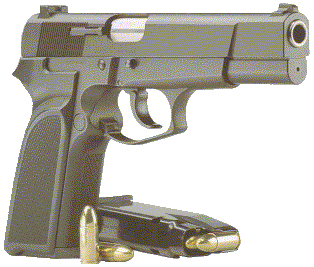
Immediately after a round is fired, the safety reengages itself even if the trigger is not released. The BDA is secured against unintentional firing with an automatic firing pin safety which blocks the firing pin and is released only when the trigger is pulled to fire. The spring-loaded external claw extractor is mounted in the slide, while the fixed ejector is inside the pistol's frame. A disconnector ensures the pistol fires in semi-automatic mode only. The recoil of the slide recocks the hammer, and all consecutive shots are fired from the single-action mode. The handgun features a double-action trigger which cocks and then releases the hammer. This locking mechanism was borrowed from the Browning Hi-Power. It has a vertically tilting delayed camming action. The FN HP-DA is a semi-automatic short recoil operated locked breech firearm. It would be succeeded by the FN Forty-Nine in 2000 and then the FN FNP in 2006. Ultimately, the production of the BDA and its variants would cease in 1999. Along with the second version, in 1990, new variations, such as compact (BDAC/HP-DAC) and double-action only (BDAO/HP-DAO) variants, also entered production. The production resumed in 1990, with the second/updated version produced with a newer style frame safety, as well being made with a new manufacturing process. Production of the FN HP-DA started in 1983, but did not sell well and was withdrawn from the markets in 1987. The first version featured a frame safety similar to the original Browning Hi-Power.

The FN HP-DA/Browning BDA had two versions during its lifetime. The Finnish Defence Forces accepted the weapon into service as their general service pistol under the designation 9.00 PIST 80 and 9.00 PIST 80–91. Ultimately, the winner of the bid was the Italian Beretta 92F. įN had the HP-DA ready for the 1983–1984 XM9 pistol trials to select a new sidearm chambered for the 9×19mm Parabellum cartridge that would equip all branches of the United States Armed Forces. The development of the BDA may have been a response to the original Hi-Power's shortcomings in the first Joint Service Small Arms Program tests conducted in the late 1970s. The BDA represents the further development of the widely used FN/Browning Hi-Power, which, by the 1980s, had been production for almost fifty years before the design of the BDA was completed. Notice the frame safety that is different on the updated/1990 model (above page).
Fn 9mm double action bda update#
The overall design layout of all versions of the pistol is based on the Browning Hi-Power, but the firearm features significant ergonomic changes designed to update the weapon to military requirements of its time.įN HP-DA, 1st version displayed at the Imatra Border Museum. GP 35 in Belgium and French-speaking countries).

Introduced in 1983, it is an update of the Browning Hi-Power (a.k.a. In North American markets, it was marketed as Browning BDA ( Browning Double Action, also BDA9) and is also referred to as Browning DA and Browning Hi-Power BDA. The magazine release button, located aft of the trigger, can be configured for either right or left-hand users simply by swapping out the push-button.FN HP-DA (second variation produced 1990–1999)ġ983–1987 (first version, standard model only)įixed iron sights, front – blade, rear – notchįN HP-DA ( Hi-Power Double Action) is a 9mm semi-automatic pistol developed by Belgian Fabrique Nationale arms factory in Herstal.
Fn 9mm double action bda manual#
The design of the HP-DA is based on the FN/Browning Hi-Power pistol but with many improvoements like double-action trigger, one more round in magazine or frame mounted decocker lever instead of manual safety. The HP-DA was marketed in Europe as the FN HP-DA and in America as Browning BDA. The FN HP-DA (BDA) is a recoil operated, locked breech semiautomatic pistol devoloped in 1983 in Belgium by FNH and manufactured until 1987.


 0 kommentar(er)
0 kommentar(er)
